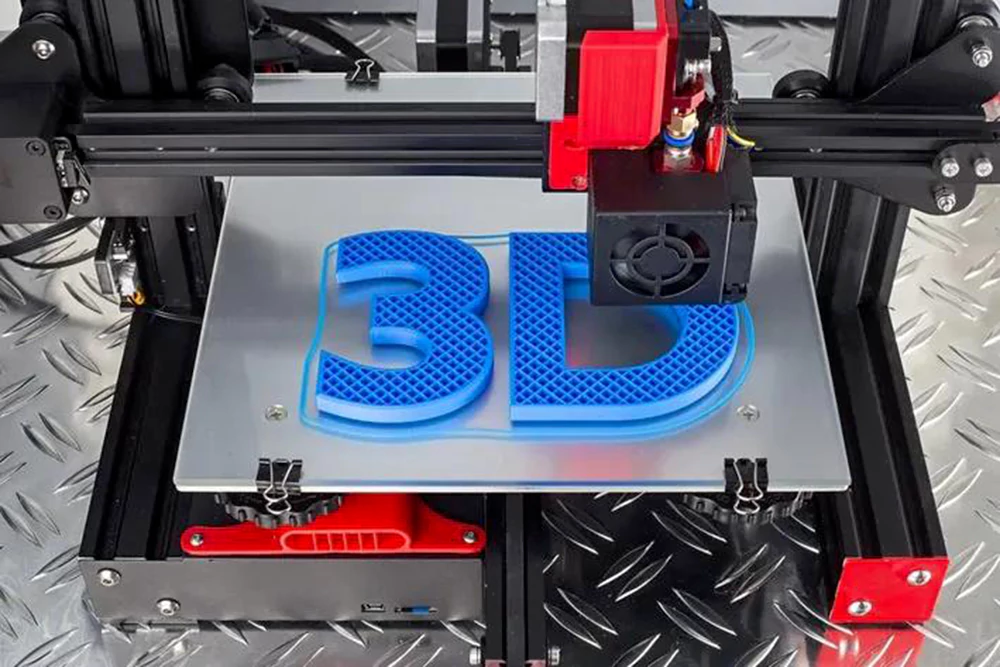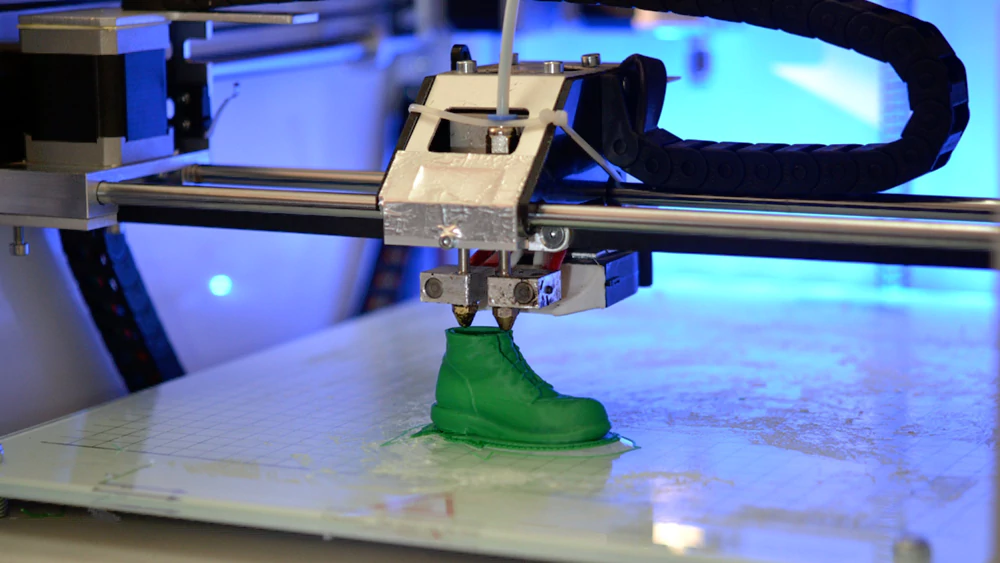3D printing is transforming manufacturing across industries from automotive to medical devices by enabling direct digital fabrication of complex, customized parts on-demand without traditional constraints.
This revolutionary technology provides greater design flexibility along with accelerated innovation cycles and supply chain agility through its additive fabrication methodology.
What is 3D Printing?
3D printing, also referred to as additive manufacturing (AM), is a transformative approach to industrial production whereby three-dimensional objects are created by depositing successive layers of material rather than traditional methods of subtractive manufacturing which rely on cutting or drilling. In 3D printing, a digital 3D model design file is sliced into thin layers which then get printed out sequentially by adding material rather than removing it.

A 3D printer constructs a physical object from the ground up, layer by layer, with expansive flexibility in geometric complexity. This allows endless part customization and optimization. Using 3D printing technology, objects of virtually any shape can be produced directly from a digital model without any specialized tools, molds or dies, offering unprecedented flexibility and efficiency.

How Does 3D Printing Work?
3D printing works by slicing a digital 3D design file into layers using special software. The 3D printer then constructs a physical object one layer at a time from the bottom up by depositing material. Steps include:
1. Making a 3D model using CAD software
2. Converting and slicing the design into layers
3. Transferring files into the 3D printer software
4. Printing begins by depositing the first layer
5. Successive layers add up to finalize the object
6. Any additional finishing steps
What is the 3D Printing Process?

The 3D printing process converts digital 3D model files into physical objects by building them up in layers using additive manufacturing technology. The major steps include:
1. Part Design: A digital 3D model is created either using CAD software or by 3D scanning an existing object into specialized scanning software.
2. STL File Export: The completed 3D model design file is then exported into STL format, the standard file type compatible with most 3D printers.
3. Slicing Software: The STL file gets imported into a slicing software program which processes the model and slices it into layers, essentially creating a print file with instructions for the 3D printer, saved as G-code.
4. 3D Printer Setup: The G-code is then transferred to the 3D printer interface and necessary setup steps are completed including calibration, positioning, and material loading before starting the print.
5. Additive Printing Process: Printing commences whereby the print head or laser selectively deposits or cures material layer-by-layer, building up from nothing to fully realize the geometry and details of the 3D model.
6. Part Removal: Once printing is finished, the user removes the completed 3D printed part from the printer bed, detaches any supports, and may also do secondary post-processing like sanding or painting on the part if desired.
7. Iterative Refinement: The quick design-to-print system then allows for effective refinement back at the 3D modeling stage and re-printing of improved versions rapidly.
What are the Advantages of 3D Printing?
3D printing provides major advantages over traditional manufacturing techniques in these key areas:
Design Freedom – Additive processes enable the creation of intricate organic shapes, complex geometries, optimized lattices and custom features unachievable through subtractive means. No tooling constraints exist.
Speed – Greatly accelerated prototyping is possible by printing design iterations in hours/days rather than waiting weeks for machined test samples. Streamlined workflow.
Cost Efficiency – No expenses for physical tooling, molds or dies that become obsolete. Cost per part drops significantly at production volumes despite higher initial printer investment.
Agile Supply Chain – On-demand printing of spare parts locally reduces lead times, inventory and logistics costs. Enables distributed manufacturing flexibility.
Part Consolidation – Significantly more conjoined functionality achievable within a single printed component vs an assembly requiring manufacturing and joining of separate parts.
Mass Customization – Unique customer-specific product personalization and regional adaptation are possible by modifying 3D model files used for printing rather than reconfiguring tools.
Waste Minimization – The additive approach deposits only the required amount of material, unlike subtractive machining which generates material scrap loss. More sustainable.
What are the Disadvantages of 3D Printing
Some drawbacks involve:
●Part Size Limitations – Restricted by printer envelope
●Speed – Relatively slow production rates
●Material Options – More limited than processes like injection molding
●Repeatability – More variability part-to-part
●Post-Processing – Support removal, surface finishing often required
What are the Applications of 3D Printing?
Thanks to key advantages like design freedom, accelerated time-to-market, and cost-efficiency at lower volumes, industrial 3D printing is enabling transformative changes across every manufacturing sector.
Some prime applications include:
Prototyping – Engineers print multiple design iterations of parts in days for evaluation rather than waiting weeks. Critical for product development phases.
Aerospace – Lightweight complex geometries printed in exotic metals for aircraft and spacecraft offer better performance-to-weight characteristics.
Medical – Customized implants, prosthetics, surgical guides and anatomical models being 3D printed for better patient matching and outcomes.
Automotive – Performance-focused printed parts for racing followed by production volume components such as metal fuel injector nozzles.
Consumer Goods – Eyeglasses, footwear and apparel incorporate customized 3D printed designs not possible using molded tooling.
Manufacturing Tools – 3D printing itself facilitates simplified tooling including jaws, grippers, and fixtures used in machining, molding and casting processes.
Military – Logistical benefits of printing spare components in deployed locations combined with design optimizations.
What are the Main Types of 3D Printers?

There are several categories of 3D printers differentiated by their underlying additive manufacturing technology, suitable materials, accuracy, part sizes, and applications:
Fused Deposition Modeling (FDM)
One of the most common and affordable printer types. Uses a thermoplastic filament thread fed through a heated print head to melt and deposit material layer by layer. Best for prototyping.
Stereolithography (SLA)
A vat of liquid photopolymer resin gets selectively cured into solid cross-sections by a laser. Known for very high accuracies and smooth surface finishes.
Selective Laser Sintering (SLS)
Powdered materials like nylon, glass, and aluminum gets fused into shape by a high-power laser. Enables more exotic materials like ceramics.
Material Jetting
Inkjet-style print heads precisely deposit tiny droplets of curable photopolymers or waxes to build objects. Allows multi-material prints.
Metal Binder Jetting
Layers of metal powder get selectively bonded by injecting a binder material to create a partially solid object before sintering in a furnace
The extensive material selection from polymers to advanced alloys combined with precision down to 25 microns offers expansive capabilities spanning concept modeling through production.
How to Choose 3D Printing Services
Factors when selecting a 3D print services provider include printer types available, material range, part size capacity, accuracy/tolerances, batch sizes suited for, and post-processing abilities. Review quality levels and manufacturing costs between service bureaus before deciding on the optimal solutions partner.
Conclusion
In summary, 3D printing or additive manufacturing provides transformative capabilities spanning from early design concepts through deployed end-use parts across an extensive range of market verticals.
The design freedom, customization, increased functionality and simplified tooling 3D printing facilitates innovation while its responsive digital inventory reduces waste and supply chain costs once deployed.
Continuous material and equipment improvements have graduated the technology from solely prototyping into finished high-performance components for industries from aerospace through sporting goods and healthcare.
3D printing streamlines designing and realizing creations that were previously impossible. The impacts promise to expand for years to come as more organizations adopt to drive efficiency and deliver new value.
3D printing, also referred to as additive manufacturing (AM), is a transformative approach to industrial production whereby three-dimensional objects are created by depositing successive layers of material rather than traditional methods of subtractive manufacturing which rely on cutting or drilling. In 3D printing, a digital 3D model design file is sliced into thin layers which then get printed out sequentially by adding material rather than removing it.
1. Part Design
2. STL File Export
3. Slicing Software
4. 3D Printer Setup
5. Additive Printing Process
6. Part Removal
7. Iterative Refinement
- Design Freedom
- Speed
- Cost Efficiency
- Agile Supply Chain
- Part Consolidation
- Mass Customization
- Waste Minimization










